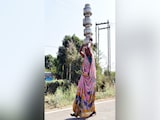The National Aeronautics and Space Administration (NASA) regularly captures stunning images of our universe, leaving space lovers mesmerized. The social media handles of the US Space Agency are a treasure trove for those who love to watch educational videos and fascinating images showcasing Earth and space. Now, NASA recently shared a stunning image of a cluster of nebulae called N11, which lies some 160-000 light-years away in the constellation Dorado. This complex cluster of emission nebulae was discovered by American astronomer and NASA astronaut Karl Gordon in 1956. The picture was captured by the space agency's Hubble Space Telescope.
In a statement, NASA described the ethereal picture as a "bubbling region of stars". "About 1,000 light-years across, N11's sprawling filaments weave stellar matter in and out of each other like sparkling candy floss," said NASA. "These cotton-spun clouds of gas are ionized by a burgeoning host of young and massive stars, giving the complex a cherry-pink appearance," it continued.
According to the space agency, the N11 complex consists of a group of emission nebulae - formations made up of light-emitting clouds of gas and dust. It is located in the Large Magellanic Cloud (LMC), a dwarf galaxy that's a cosmic neighbour of our own Milky Way.
N11 is one of the largest and most energetic regions in the LMC. this dwarf galaxy is also a satellite galaxy, meaning it orbits Milky Way. It's a relatively small galaxy, but it's an active place for star formation. As per NASA, N11 is one of the largest and most energetic regions in the LMC. Scientists are using Hubble to better understand the types of stars within N11 and how they're distributed.
Also read | Microplastics Invade Human Brains, Researchers Call For Global Emergency
"Throughout N11, colossal cavities burst from the fog. These bubbles formed as a result of the vigorous emergence and death of stars contained in the nebulae. Their stellar winds and supernovae carved the surrounding area into shells of gas and dust," NASA explained.
A nebula is a giant cloud of dust and gas in space. Some nebulae (more than one nebula) come from the gas and dust thrown out by the explosion of a dying star, such as a supernova. Other nebulae are regions where new stars are beginning to form.
Nebulae are beautiful to look at, and they can tell us about how stars are born, live and die. Our own sun formed in a nebula around 4.6 billion years ago.















